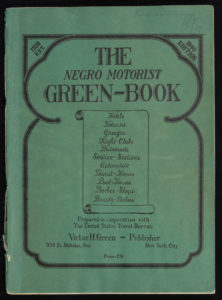Mosaic Templars Cultural Center will host a block party to celebrate opening night.

The Negro Motorist Green Book, created in 1936 by Harlem postman Victor Green, was a guide that helped African Americans travel the country safely during a time of Jim Crow laws and segregation. An exhibition developed by the Smithsonian Institution Traveling Exhibition Service exploring the history of The Green Book opens at Mosaic Templars Cultural Center tomorrow.
“The book lists hotels, restaurants, gas stations, beauty colleges, barbershops — places that African Americans could go and that were safe for them to go as they traveled to their destination,” MTCC curator of collections Courtney Bradford says.

Courtesy Schomburg Center for Research in Black Culture, Jean Blackwell Hutson Research and Reference Division, New York Public Library.
The Standard Oil Company of New Jersey, known today as ExxonMobil, was the only major retail distributor of The Green Book through its network of Esso stations. In 1949, A.C. Lewis opened an Esso station at 901 Locust Street in North Little Rock. He was one of only three African American franchisees in the state.
Lewis was also Bradford’s great uncle. He passed away when she was a baby, but Bradford recalls spending time in the shop growing up. However, she had “absolutely no idea” about the station’s significance until she learned more about Green Book sites while doing research in graduate school.
“A business that their father started in 1949, it’s still very much still alive today…I assisted them with their business and now I’m assisting with bringing that history out for everyone to see,” Bradford says.
Pictures from the Lewis family are being added to photographs and artifacts already included in the traveling exhibit, helping to personalize the show during its time in Arkansas. Little Rock is the second stop for the Smithsonian exhibit, which debuted Oct. 20 at National Civil Rights Museum in Memphis.
The exhibit is broken down into seven sections, Bradford says. The four main sections explore directions — north, south, east and west — and what African American travelers could have expected on their journey to their different destinations. The remaining three sections focus on history, the journey and what can be done to preserve the history of Green Book sites.
“This exhibit delves into the impact of travel and segregation while highlighting hopes and successes of African American communities throughout the South,” interim director Quantia Fletcher says. “Arkansas has direct ties to The Green Book, including sites across our state that were listed in the guide and served as safe places for Black travelers.”

From the Velvatex College of Beauty Culture, Little Rock, Arkansas.
Courtesy of the Mosaiac Templars Cultural Center, Little Rock, Arkansas.
Photo by James Kegley.
There were more than 230 Arkansas sites listed in The Green Book, including Velvatex Beauty College, which is part of the Smithsonian exhibit. Established in 1926, it was Little Rock’s only approved school for people of color. The school, now known as Velvatex College of Beauty Culture, Inc., is still in operation. It’s located about a mile southwest from MTCC.
A lot of effort has gone into transporting and installing the exhibition at Mosaic Templars Cultural Center, and Bradford is looking forward to welcoming the public into their space to see the final product.
“We are just so excited to have it, so honored to have it, and we want you all to come out and enjoy it and to learn about the piece of history that is not often talked about,” she says.
MTCC will celebrate the opening of The Negro Motorist Green Book from 6 to 8:30 p.m. May 20 with a block party that will include food trucks, a live DJ and cars on display. The exhibition is on view through Aug. 1. Admission is free, but Bradford says guests should reserve tickets in advance.
Walking tours of Ninth Street are also being offered once a month while the exhibition is in Little Rock. Tours are every fourth Saturday in May, June and July. The first tour is at 9 a.m. Saturday. More information is available at www.mosaictemplarscenter.com.
To see digitized versions of The Green Book, visit the New York Public Library’s digital collection.

